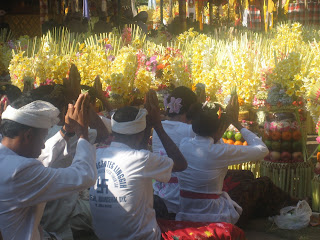Bali is celebrating Hari Raya Galungan
Bali’s culture is based on a form of Hinduism called Hindu Darma, which is believed to have arrived on the island during the 11th century from the ancient kingdom of Java, Majapahit. This religion plays a heavy part in family customs and community lifestyle but is a world away from that of India’s Hindu. The cultural background explains usage of two calendar systems; Pawukon (from the word Wuku; means week) and Saka. The Pawukon consists of 30 weeks and is a 210 day ritual calendar brought over from Java in the 14th century. While Saka, a 420 day system is a lunar calendar that originally came from South India and was brought to Indonesia around 465 a.d. One Saka year has 12 months and each month consists of 35 days.
Balinese celebrate GalungaN every 210 days during Wuku Dungulan. This festival is symbolizing the victory of dharma (virtue) upon adharma (the evil). As the expression of victory, people will fit penjor – a tall bamboo splendidly decorated with woven young coconut leaves, fruit, cakes and flowers, as offerings to God. This penjor is placed on the right side of every house entrance. People are attired in their finest clothes and jewels on that day. The Galungan, Bali’s major feast, is held throughout the island. The whole festival lasts for ten days. During this ten day period, all the Gods, including the supreme deity Sanghyang Widi, come down to earth for the festivities. Barongs prance from temple to temple and all over every village. The last and most important day of the ten day festival is called Kuningan.











There is a high ratio of yoga instructors, meditation teachers, and bodyworkers compared to most any place else in North America. I was in Sedona, AZ earlier this year and Hornby reminds me of there with the same feel of land charged with spirit. Ilchi Lee
ReplyDelete